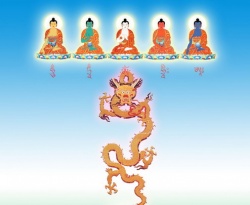Difference between revisions of "Tulpa"
(Created page with "thumb|250px| <poem> Tulpa (Tibetan: སྤྲུལ་པ, Wylie: sprul-pa; Sanskrit: निर्मित nirmita[1] and निर्मा...") |
|||
| Line 1: | Line 1: | ||
[[File:5 Dhyani Buddhas01.jpg|thumb|250px|]] | [[File:5 Dhyani Buddhas01.jpg|thumb|250px|]] | ||
<poem> | <poem> | ||
| − | Tulpa (Tibetan: སྤྲུལ་པ, Wylie: sprul-pa; Sanskrit: निर्मित nirmita[1] and निर्माण nirmāṇa; "to build" or "to construct") is a concept in mysticism of a being or object which is created through sheer discipline alone. It is a materialized | + | Tulpa (Tibetan: སྤྲུལ་པ, Wylie: sprul-pa; [[Sanskrit]]: निर्मित nirmita[1] and निर्माण nirmāṇa; "to build" or "to construct") is a concept in mysticism of a being or object which is created through sheer discipline alone. It is a materialized [[Thought]] that has taken physical [[Form]] and is usually regarded as synonymous to a thoughtform. |
| − | Tibetan Buddhism | + | [[Tibetan Buddhism]] |
| − | Tulpa is a | + | Tulpa is a [[Spiritual]] discipline and teachings concept in [[Tibetan Buddhism]] and Bon. The term 'thoughtform' is used as early as 1927 in Evans-Wentz translation of the [[Tibetan Book of the Dead]], described as "giving palpable being to a visualization, in very much the same manner as an architect gives concrete expression in three dimensions to [...] his blue-print". |
| − | John Myrdhin Reynolds in a note to his English translation of the | + | John Myrdhin Reynolds in a note to his English translation of the [[Life]] story of [[Garab Dorje]] defines a tulpa thus: |
| − | A Nirmita (sprul-pa) is an emanation or a manifestation. A Buddha or other realized being is able to project many such Nirmitas simultaneously in an infinite variety of forms. | + | A Nirmita (sprul-pa) is an emanation or a manifestation. A [[Buddha]] or other realized being is able to project many such Nirmitas simultaneously in an infinite variety of forms. |
| − | The term is used in the works of Alexandra David-Néel, who claimed to have created a tulpa in the image of a jolly Friar Tuck-like | + | The term is used in the works of Alexandra David-Néel, who claimed to have created a tulpa in the image of a jolly Friar Tuck-like [[Monk]] which later developed a [[Life]] of its own and had to be destroyed. |
Thoughtform | Thoughtform | ||
| − | Thought- | + | [[Thought-Form]] of the Music of Gounod, according to Annie Besant and C.W. Leadbeater in [[Thought]] Forms (1901) |
A thoughtform is the equivalent concept to a tulpa but within the Western occult tradition. The Western understanding is believed to have originated as an interpretation of the Tibetan concept. Its concept is related to the Western philosophy and practice of magick. | A thoughtform is the equivalent concept to a tulpa but within the Western occult tradition. The Western understanding is believed to have originated as an interpretation of the Tibetan concept. Its concept is related to the Western philosophy and practice of magick. | ||
Revision as of 23:00, 23 April 2013
Tulpa (Tibetan: སྤྲུལ་པ, Wylie: sprul-pa; Sanskrit: निर्मित nirmita[1] and निर्माण nirmāṇa; "to build" or "to construct") is a concept in mysticism of a being or object which is created through sheer discipline alone. It is a materialized Thought that has taken physical Form and is usually regarded as synonymous to a thoughtform.
Tibetan Buddhism
Tulpa is a Spiritual discipline and teachings concept in Tibetan Buddhism and Bon. The term 'thoughtform' is used as early as 1927 in Evans-Wentz translation of the Tibetan Book of the Dead, described as "giving palpable being to a visualization, in very much the same manner as an architect gives concrete expression in three dimensions to [...] his blue-print".
John Myrdhin Reynolds in a note to his English translation of the Life story of Garab Dorje defines a tulpa thus:
A Nirmita (sprul-pa) is an emanation or a manifestation. A Buddha or other realized being is able to project many such Nirmitas simultaneously in an infinite variety of forms.
The term is used in the works of Alexandra David-Néel, who claimed to have created a tulpa in the image of a jolly Friar Tuck-like Monk which later developed a Life of its own and had to be destroyed.
Thoughtform
Thought-Form of the Music of Gounod, according to Annie Besant and C.W. Leadbeater in Thought Forms (1901)
A thoughtform is the equivalent concept to a tulpa but within the Western occult tradition. The Western understanding is believed to have originated as an interpretation of the Tibetan concept. Its concept is related to the Western philosophy and practice of magick.
